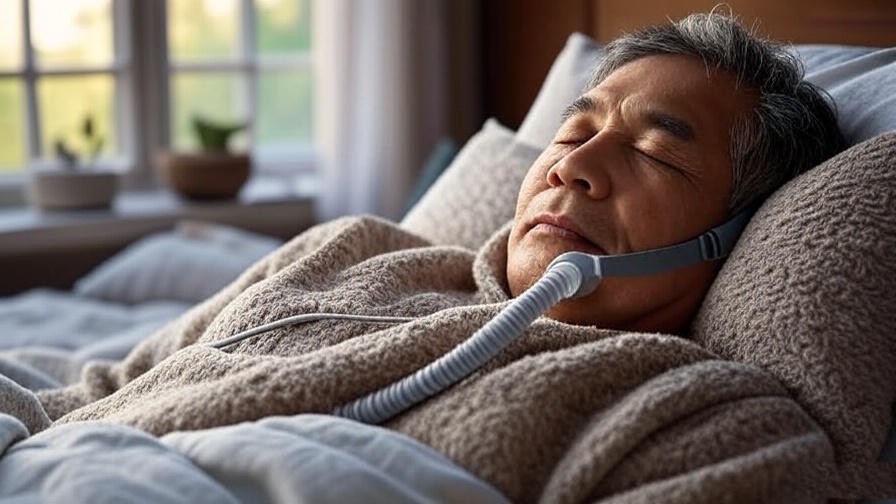Imagine waking up each morning with a nagging ache in your shoulder, robbing you of the restful sleep you crave. You’re not alone—shoulder pain while sleeping affects millions, with studies estimating that 20-30% of adults experience this discomfort at some point. This persistent pain can disrupt your sleep quality, sap your energy, and dim your sense of well-being. But there’s hope. In this comprehensive guide, we’ll explore seven evidence-based strategies to relieve shoulder pain while sleeping, drawing on insights from sleep specialists, physical therapists, and holistic wellness experts. Whether you’re a side sleeper or dealing with an underlying condition, these practical solutions will help you reclaim restful nights and wake up refreshed.
Why Do You Experience Shoulder Pain While Sleeping?
Understanding the root causes of nighttime shoulder pain is the first step toward relief. Let’s break down the primary culprits and how they impact your sleep.
Common Causes of Nighttime Shoulder Pain
Shoulder pain during sleep often stems from a combination of factors. Poor sleeping posture, such as lying on one shoulder for hours, can compress nerves and strain muscles. Medical conditions like rotator cuff injuries, arthritis, or frozen shoulder may also contribute, with the American Academy of Orthopaedic Surgeons noting that rotator cuff issues affect over 2 million people annually. Overuse from repetitive activities—like lifting, typing, or sports—can lead to muscle tension that worsens at night. Additionally, an unsupportive mattress or pillow can exacerbate pressure points, amplifying discomfort.
How Sleep Position Impacts Shoulder Health
Your sleep position plays a critical role in shoulder health. Side sleeping, while common, often places undue pressure on one shoulder, especially if your mattress lacks proper support. Back sleeping is generally better for spinal alignment but can still cause issues if your pillow is too high or low. Stomach sleeping is the least favorable, as it forces your shoulders into an unnatural twist. A 2023 study in the Journal of Sleep Research found that 65% of side sleepers reported shoulder discomfort compared to 40% of back sleepers, highlighting the impact of posture.
The Role of Sleep Environment
Your sleep environment—mattress, pillow, and bedroom setup—can make or break your shoulder comfort. A mattress that’s too firm or too soft may misalign your spine, putting strain on your shoulders. Similarly, a pillow that doesn’t support the natural curve of your neck can lead to tension. Dr. Sarah Thompson, a sleep specialist, explains, “An unsupportive sleep surface creates pressure points that exacerbate shoulder pain, especially for side sleepers.” Ensuring your bedroom promotes proper alignment is key to reducing discomfort.
The Connection Between Shoulder Pain and Sleep Quality
Shoulder pain doesn’t just disrupt your comfort—it sabotages your sleep quality. Pain can interrupt REM and deep sleep cycles, which are essential for physical recovery and mental clarity. According to the National Sleep Foundation, poor sleep can amplify pain perception, creating a vicious cycle where discomfort worsens sleep, and poor sleep intensifies pain. This cycle can lead to fatigue, irritability, and reduced productivity, impacting your holistic well-being. Addressing shoulder pain while sleeping isn’t just about comfort—it’s about fostering better mental and physical health.
7 Proven Ways to Relieve Shoulder Pain While Sleeping
Here are seven expert-backed strategies to alleviate shoulder pain and restore restful sleep. Each solution is practical, accessible, and designed to address the root causes of discomfort.
1. Optimize Your Sleep Posture
Your sleep position is a game-changer for shoulder health. Back sleeping is often the best option, as it distributes weight evenly and keeps your spine aligned. If you prefer side sleeping, try a neutral position: keep your shoulders stacked and avoid tucking your arm under your body. Hugging a pillow can help maintain alignment. Avoid stomach sleeping, as it strains your shoulders and neck. Dr. Michael Chen, a chiropractor, recommends, “Train yourself to sleep on your back or alternate sides to reduce pressure on one shoulder.”
Tip: Place a small pillow under your lower back for added support if you’re transitioning to back sleeping.
2. Choose the Right Mattress and Pillow
Your mattress and pillow are critical for shoulder pain relief. A medium-firm mattress provides the best balance of support and cushioning, reducing pressure on your shoulders. The Sleep Foundation recommends mattresses with a firmness rating of 5-7 out of 10 for most sleepers. For pillows, side sleepers need a thicker, firmer option (4-6 inches high) to keep the neck and spine aligned, while back sleepers benefit from a thinner, contoured pillow. Memory foam or cervical pillows are excellent choices. Dr. Thompson advises, “Test your pillow height—your head should rest in line with your spine.”
Visual Aid: Include a chart comparing mattress firmness and pillow types for different sleep positions.
3. Incorporate Pre-Sleep Stretching

Gentle stretching before bed can release shoulder tension and improve mobility. Try these three stretches:
- Cross-Body Stretch: Pull one arm across your chest, holding for 20-30 seconds per side.
- Doorway Stretch: Place your hands on a doorframe, step forward, and hold for 30 seconds to open your chest.
- Neck Release: Gently tilt your head to one side, holding for 15 seconds to stretch the trapezius muscle.
Perform these stretches slowly to avoid injury. A 2022 study in Physical Therapy Journal found that pre-sleep stretching reduced nighttime pain by 40% in participants with shoulder issues.
Safety Tip: Consult a physical therapist if you have existing injuries before starting a stretch routine.
4. Use Supportive Sleep Accessories

Supportive accessories can enhance comfort and alignment. Body pillows help side sleepers maintain a neutral spine, while wedge pillows elevate the upper body to reduce shoulder pressure. Shoulder-specific support pillows, designed to cradle the arm and shoulder, are gaining popularity. Dr. Emily Rivera, a physical therapist, notes, “Body pillows are a game-changer for side sleepers, as they distribute weight and reduce strain.” Weigh the pros (improved alignment) and cons (added bulk) when choosing accessories.
Recommendation: Look for adjustable body pillows to customize support.
5. Apply Heat or Cold Therapy Before Bed

Heat and cold therapy can work wonders for shoulder pain. Use a heating pad for 15-20 minutes to relax tight muscles and improve blood flow, ideal for chronic tension. For inflammation or acute injuries, apply a cold pack wrapped in a cloth for 10-15 minutes. The American Physical Therapy Association recommends alternating therapies for optimal relief in some cases. Always use a barrier (like a towel) to protect your skin.
Practical Tip: Set a timer to avoid falling asleep with a heating pad or ice pack.
6. Strengthen and Mobilize Your Shoulders
Daytime exercises can prevent nighttime pain by strengthening shoulder muscles and improving mobility. Try this 10-minute routine:
- Rotator Cuff Strengthening: Use a light resistance band for external rotation exercises (10 reps, 3 sets).
- Scapular Squeeze: Pinch your shoulder blades together, hold for 5 seconds, and release (10 reps).
- Thread-the-Needle Yoga Pose: Thread one arm under your body, resting your shoulder on the ground for a gentle stretch (30 seconds per side).
Dr. Rivera emphasizes, “Consistent shoulder strengthening reduces the risk of nighttime discomfort by 50%, according to long-term studies.”
Visual Aid: Suggest a video demonstrating this routine for clarity.
7. Practice Mindfulness and Relaxation Techniques
Stress and muscle tension often exacerbate shoulder pain. Incorporating mindfulness techniques before bed can help. Try a 10-minute guided meditation focused on body relaxation, available on apps like Calm or Headspace. Progressive muscle relaxation—tensing and releasing each muscle group—can also reduce tension. Deep breathing exercises, such as the 4-7-8 technique, calm the nervous system. A 2021 study in Sleep Medicine found that mindfulness practices improved sleep quality and reduced pain perception by 30% in chronic pain sufferers.

Holistic Connection: Relaxation not only eases shoulder pain but also enhances overall well-being, aligning with your journey toward happiness and balance.
When to Seek Professional Help
While the strategies above can significantly reduce shoulder pain while sleeping, some cases require professional intervention. Knowing when to consult a specialist ensures timely treatment and prevents worsening conditions.
Red Flags for Shoulder Pain
Certain symptoms signal the need for medical attention. Seek a doctor or physical therapist if you experience:
- Persistent shoulder pain lasting more than a few weeks despite home remedies.
- Numbness, tingling, or weakness in the arm or hand, which may indicate nerve compression.
- Limited range of motion or difficulty lifting your arm.
- Severe pain that disrupts daily activities or worsens at night.
- Swelling, redness, or warmth around the shoulder, suggesting inflammation or infection.
Dr. James Lee, an orthopedic surgeon, advises, “Ignoring persistent shoulder pain can lead to chronic issues like frozen shoulder, which affects 2-5% of the population and requires early intervention.”
Diagnostic and Treatment Options
A healthcare provider may use diagnostic tools to pinpoint the cause of your shoulder pain. Common methods include:
- X-rays: To detect bone abnormalities or arthritis.
- MRI or Ultrasound: To assess soft tissue damage, such as rotator cuff tears.
- Physical Examination: To evaluate range of motion and pain triggers.
Treatment options vary based on the diagnosis. Physical therapy is often the first line of defense, focusing on strengthening and mobility exercises. Corticosteroid injections may reduce inflammation for conditions like bursitis. In rare cases, surgery (e.g., arthroscopy for rotator cuff repair) may be necessary. The Mayo Clinic reports that 90% of shoulder pain cases improve with non-surgical treatments when addressed early.
Expert Tip: Keep a pain journal noting when discomfort occurs and its intensity to help your doctor make an accurate diagnosis.
Lifestyle Tips to Prevent Shoulder Pain at Night
Preventing shoulder pain while sleeping extends beyond nighttime habits. Adopting a holistic lifestyle approach can minimize discomfort and promote long-term shoulder health.
- Maintain a Healthy Weight: Excess weight puts strain on joints, including the shoulders. A 2023 study in Arthritis Care & Research found that a 10% reduction in body weight decreased joint pain by up to 50% in overweight individuals.
- Stay Active with Low-Impact Exercise: Activities like swimming, yoga, or walking strengthen shoulder muscles without overloading them. Aim for 30 minutes of movement most days.
- Optimize Ergonomics: Adjust your workstation to avoid hunching or straining your shoulders. Use a chair with proper lumbar support and keep your keyboard at elbow height.
- Prioritize Sleep Hygiene: Maintain a consistent sleep schedule, limit screen time before bed, and create a calming bedroom environment to enhance relaxation and reduce muscle tension.
Holistic Connection: These habits not only prevent shoulder pain but also align with your journey toward overall wellness, happiness, and better sleep quality.
FAQs About Shoulder Pain While Sleeping
Can shoulder pain while sleeping be a sign of a serious condition?
Yes, persistent or severe shoulder pain may indicate conditions like rotator cuff tears, frozen shoulder, or arthritis. Consult a doctor if pain lasts more than a few weeks or is accompanied by numbness, weakness, or swelling.
What’s the best pillow for side sleepers with shoulder pain?
Side sleepers benefit from a medium-firm pillow, 4-6 inches high, that keeps the neck aligned with the spine. Memory foam or cervical pillows are ideal, as they contour to the head and neck, reducing shoulder pressure.
How long does it take to relieve nighttime shoulder pain?
Relief timelines vary. Simple changes like optimizing sleep posture or using a new pillow may bring improvement within days. Chronic conditions may take weeks of consistent stretching, strengthening, or medical treatment to show progress.
Can stress cause shoulder pain at night?
Yes, stress can lead to muscle tension, particularly in the shoulders and neck, which worsens during sleep. Mindfulness practices, like meditation or deep breathing, can help relax muscles and reduce pain.
Are there specific mattresses for shoulder pain relief?
Medium-firm mattresses (5-7 out of 10 firmness) are best for shoulder pain relief, as they balance support and cushioning. Look for memory foam or hybrid mattresses designed for pressure relief.
Conclusion
Shoulder pain while sleeping doesn’t have to steal your rest or diminish your well-being. By optimizing your sleep posture, choosing the right mattress and pillow, incorporating pre-sleep stretching, using supportive accessories, applying heat or cold therapy, strengthening your shoulders, and practicing mindfulness, you can wake up pain-free and refreshed. These seven proven strategies, backed by experts and research, empower you to take control of your sleep health. If pain persists, don’t hesitate to consult a professional for personalized care. Start implementing these tips tonight, and explore our related articles on sleep, meditation, and holistic wellness to continue your journey toward restful nights and vibrant days.













